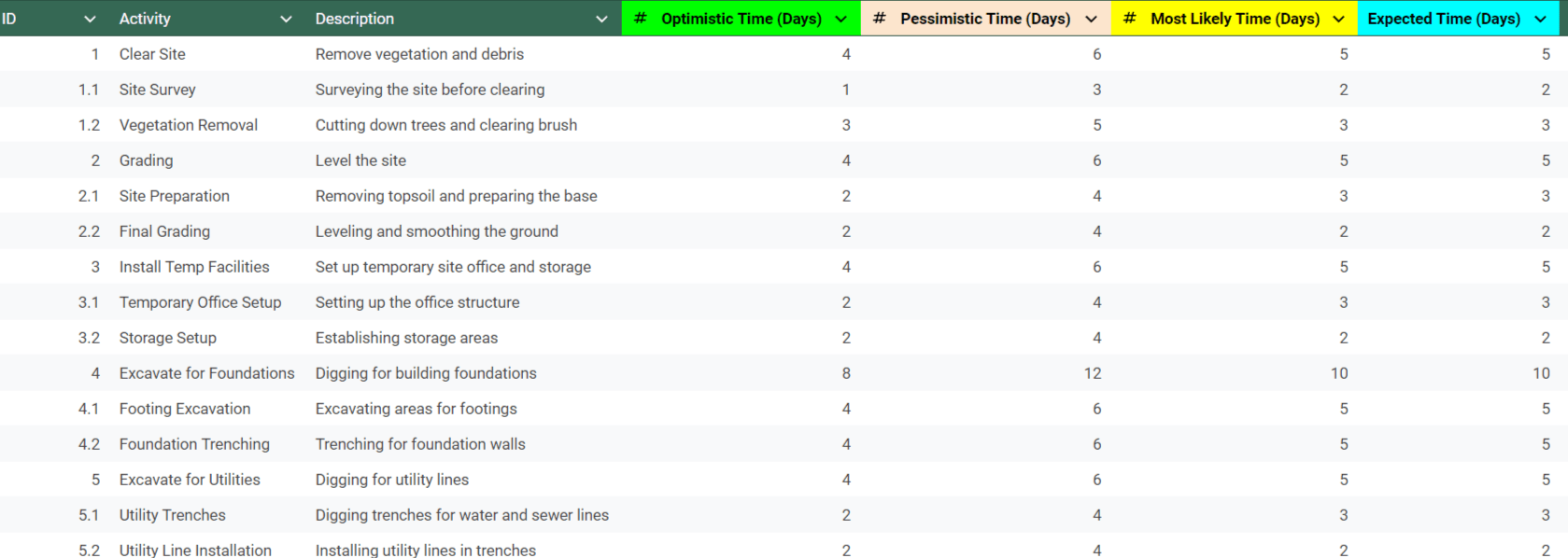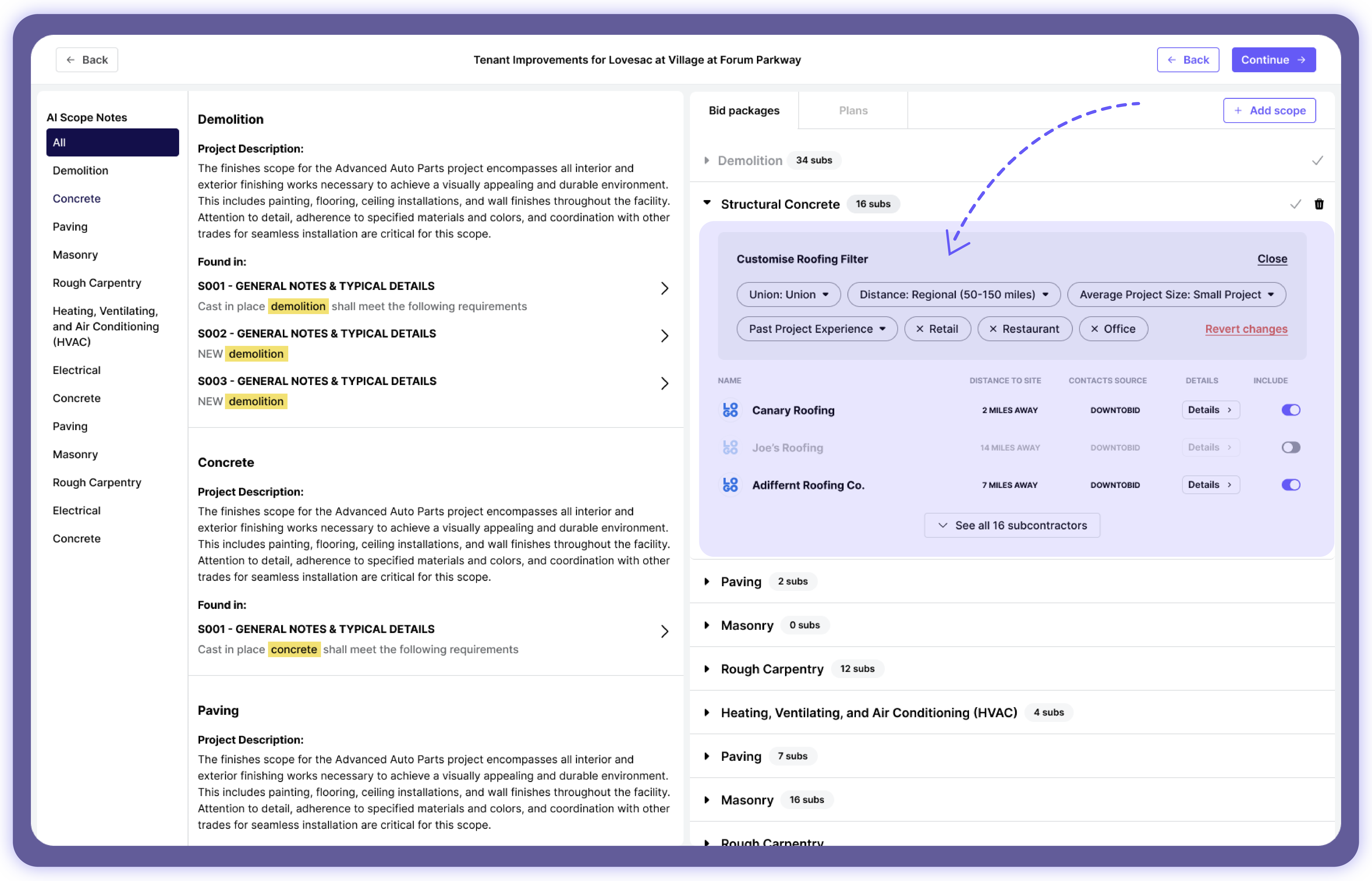You rely on your construction projects to run like clockwork, and a schedule plays a big part in that. Get it right, and you're steering your project smoothly towards completion, keeping everything under budget.
Get it wrong, though, and things can go south fast. Delays, liquidated damages, and unexpected costs can all stem from a poorly crafted schedule. To nail down your schedule (the first time), you need a commercial construction schedule template that provides the framework to guide the entire process. In this guide, you'll get free, plug-and-play templates you can start using today.
Note: Save time on the initial page turn by using Downtobid to identify scopes within your complex construction plans. Just upload your documents (for free), and our AI will do the heavy lifting for you. It’ll also connect you with local, qualified subcontractors for your project and send personalized ITBs to get them interested. What typically takes hours now takes just minutes with Downtobid. Give us a try and sign up for a demo today.
Key Takeaways
- Construction schedules outline sequence, duration, responsibilities for all project activities during preconstruction.
- Components: work breakdown structure, duration, float time, milestones, dependencies, baselines.
- Two templates: Critical Path Method (crucial tasks) and PERT (optimistic/pessimistic scenarios).
- Templates manage resources, deadlines, task sequencing, budget allocation.
- Downtobid automates scope identification and connects with qualified subcontractors via personalized ITBs.
Construction Project Scheduling in a Nutshell
A construction schedule is a comprehensive timeline that lays out the sequence and duration of every activity involved in a commercial construction project. It explains:
- What needs to be done
- When it’ll happen
- Who’s responsible
- Where it’ll take place
Scheduling typically happens during the preconstruction planning phase, when you're laying the groundwork for your project. Here's where you map out every detail, defining how and when things will unfold.
A well-written construction schedule is realistic, accurate, and well-sequenced, and it should cover:
- Resource management
- Allocated assets
- Relevant deadlines
- Specific tasks to be completed
- Any task dependencies
- All project deliverables
- Project task durations
- Set construction budgets and costs
The Building Blocks of Construction Schedules
Let's break down the key terms you'll need to master construction scheduling:
- Work Breakdown Structure (WBS): It captures 100% of the work in your project's scope and breaks it down into smaller, manageable pieces. Doing so helps you see how the different activities relate and start building your schedule. You can download our work breakdown structure template here.
- Duration: A precise estimate of how long each activity will take.
- Float: The amount of time an activity can be delayed without affecting the start date of any following activities in the construction phase.
- Project Milestones: These as the major checkpoints in your project, and they show the start or finish of significant events in your project plan outline.
- Dependencies: These are the connections between project activities; they help construction project managers see how tasks are linked together.
- Lag Time: The extra time, either positive or negative, associated with the relationship between two tasks.
- Lead Time: Crucial for effective construction project management, it's the time it takes for critical materials or equipment to arrive on-site.
- Baseline Schedule: The approved version of your construction project schedule, it stays constant and acts as a comparison point for actual results.
What’s Included in Our Free Construction Schedule Templates?
There are several types of construction templates you can use, but for the sake of simplicity, we’ve narrowed them down to the two most common:
- Critical Path Method (CPM): Helps you identify the most important tasks that can’t be delayed without affecting the entire construction project timeline.
- PERT (Program Evaluation Review Technique): Allows you to estimate the time required for each task and account for uncertainty in your project schedule.
We’ll break down each one in just a minute. But before you start using a construction schedule template, keep these two tips in mind:
- Enter all the details: Being detail-oriented is key to managing construction projects successfully. Resist the temptation to write down the basics and move on to the next step. Flesh out all the details of each task so you’re clear on how it fits into your project schedule. The more detail, the better you’ll be able to manage and track progress.
- Avoid being overly optimistic: Sure, a task might take five days if everything goes perfectly, but that’s rarely the case. Weather can delay things, equipment might break down, and unexpected issues can crop up. If one task runs long, you can adjust by drawing time from other tasks where you’ve also allowed some wiggle room.
Critical Path Method
Every project needs a certain amount of time to get done. Think of it like a series of steps that have to happen in a specific order. Consider the example of a residential construction project. First, you lay the foundation, then you put up the framework, install plumbing and electrical systems, and finally, you do the painting and interior work.
Each step has to wait for the previous one to be completed, and the total time to complete these steps is how long your project will take.
Now, ordering materials? You can do that while working on other tasks, so it doesn’t add to the overall project duration. And if it gets delayed, it won’t necessarily hold up the entire project. Only the steps that form the longest sequence from start to finish affect the project duration -- foundation work, erecting frameworks, plumbing, etc. This sequence is called the critical path, and these are your critical tasks.
Knowing the critical path is probably the most important factor for any construction project. Any activity on the critical path should be watched closely to avoid delays, which would affect the entire project’s workflow and duration. Similarly, any activities that the path activities depend on within the schedule can delay the critical path if they finish late or somehow affect it.
Our critical path template follows a simple structure that you can easily customize with your details. It also uses a work breakdown structure to help you visualize your entire project better. You can make a copy of the free template here.

That said, the critical path method might not be the only tool you need, especially for projects with hundreds of interconnected tasks. While you might identify a critical path, you could fail to account for resources required by tasks that depend on those within the path.
In short, the critical path method isn’t a one-size-fits-all solution for scheduling construction projects. That’s why we’ve included another template:
PERT
While many project frameworks focus on predicting the most likely timeline, PERT takes it a step further. It considers three scenarios: the shortest possible time, the most likely time, and the longest possible time. Using these, PERT calculates a weighted average, giving you a more accurate estimate.
The project framework lays out your schedule clearly, distinguishing between fixed deadlines and flexible milestones. It keeps those fixed deadlines in view while making it easy to collaborate across teams, even on complex projects.
Our PERT template helps you create different timelines for project completion. Here’s what it covers:
- Optimistic time: The best-case scenario.
- Pessimistic time: The longest time you think it might take.
- Most likely time: When you expect to finish if everything goes smoothly.
- Expected time: A realistic estimate that accounts for problems, which are pretty common in construction.

You can grab your copy of the residential construction schedule template here.
Keep Your Construction Project Sailing Smoothly with Downtobid
Creating a schedule means you need to see the big picture — the 10,000 ft bird’s eye view. But it’s tough to focus on that big picture when tiny details bog you down. For example, identifying scopes in construction plans (50+, 100+ pages long) can be a real headache. Estimating teams typically waste hours digging through these plans and spec sheets to identify bidding opportunities hidden within their designs. It's often a mundane task that doesn’t truly define your value as an estimator.
That’s where Downtobid steps in. Instead of getting caught up in tedious tasks, you can focus on what really matters — work that adds value for your clients and project owners, like value engineering, problem-solving and optimizing project costs.
With our software, the AI does the heavy lifting. It digs deep into construction plans to identify project scopes, catching contradictions in DDs and SDs, saving you countless hours.

But that’s not all. Our platform helps you find the right subcontractors for your job, whether through our extensive network or a curated list of qualified subcontractors based on your uploaded construction plans.
Plus, our platform generates personalized ITBs, addressing subs by name, project history, and trade expertise in the initial messages. Our automated follow-up sequences also ensure timely bid confirmations, boosting your bid response rates.
Get a free demo today and see how Downtobid can streamline your preconstruction process.